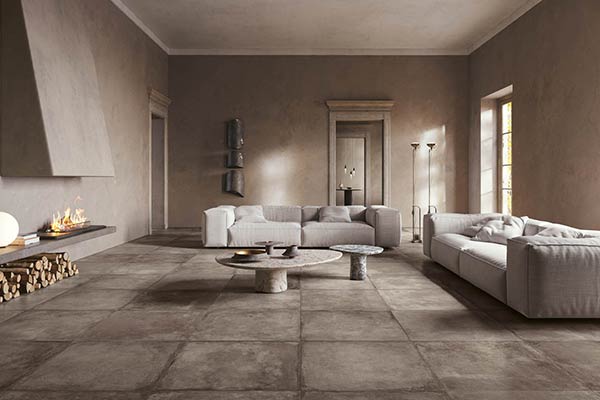Natural stone tiles
The benefits of natural stone tiling
Natural stone tiles are renowned for their good looks, sturdiness and durability. In addition to these advantages, it is an excellent conductor of heat and an environmentally-friendly material that is easy to maintain.
Attractive tiles
As a result of its texture and shade, natural stone tiles stand out from the rest in terms of aesthetics. It is original and warm. What’s more, the finishes come in a range of models. Some are even rare and add value to your property. This is the case, for example, with Hainaut blue stone, Vals stone or Atlas stone from Morocco.
Robust tiles
The density and components of natural stone make it a robust material. Natural stone tiles are resistant to temperature variations, scratches and impacts. As a result of these characteristics, many models are ideal for outdoor use.
Eco-friendly tiles
By investing in natural stone tiles, you’re opting for an environmentally-friendly material. The material used comes from rocks that have formed naturally. Both extraction and exploitation are regulated. Finally, the design does not require any chemicals. A natural stone tile is even eco-responsible, because as well as being environmentally friendly, it is sustainable. This limits overproduction and overconsumption.
Tiles that are easy to maintain
Maintaining natural stone tiles is easy.
Heat-conducting tiles
The problem with tiling is the cold. Putting your feet up on the floor becomes an ordeal in winter when the surface is tiled. Not so with natural stone, if you have underfloor heating. Natural stone tiles transmit the heat emitted by the heating.
Tiles Effect Stone
There are countless models of natural stone tiles. The choice mainly depends on your taste. Here are some of the most popular models to help you choose.



Travertine tiles
Tiling designed with this natural stone is polyvalent. You can lay it outside, as a pool deck or even on the terrace. You can also use it as an indoor floor covering. This stone stands out for its brilliance, no matter what colour you choose.
Burgundy stone tiles
A Burgundy stone tile reflects elegance. This type of tile is found in luxury homes, sophisticated residences, etc. Beige is the most popular colour, as it’s soft, chic and makes the flooring timeless.
Marble tiles
Marble is both design and decorative. It can be found just about anywhere, whether on the bathroom floor, a section of wall or even the kitchen worktop. Marble, whatever its colour, always adds brightness to the room it’s in. Marble tiles are generally used indoors.
Egyptian stone tiles
Egyptian stone is one of the strongest natural stones. That’s why it’s suitable for both indoor and outdoor use. It is highly resistant to impact and climatic variations. In terms of aesthetics, it’s highly design-led and suits all types of interior decoration and style.
Bluestone tiles
Bluestone tiles are generally used outdoors. The natural light adds value to its shades. You can, of course, use it as an indoor covering, especially if the style and decor of your home is contemporary. It goes well with industrial materials such as steel.
Kandla stoneware tiles
Kandla sandstone is a natural stone that is robust and aesthetically pleasing. It stands out for its original shades, reminiscent of grey, blue, beige and parma. Its rough texture is perfect for the bathroom or even outdoors, as pool coping.
Slate tiles
Slate is a natural stone that is often underestimated, even though it has so much potential. It can be used indoors as bathroom tiles, living room tiles, etc. Its shades allow you to create a contemporary mineral atmosphere. Slate can also be used as outdoor tiles to create a Zen garden for example.
Atlas stone tiles
This tile comes in light grey. Its soft shades perfectly embellish a contemporary living room or even a designer dining room. Its neutral colour is also suitable for other rooms, but also for outdoor installation. You can lay Atlas stone tiles on your terrace, along driveways, etc.
How much do natural stone tiles cost?
Natural stone tiles are expensive. On average, the purchase and installation price is between €20 and €200, depending on the type of natural stone you choose. This price is explained by the quality and durability of this covering. A carpet lasts around 10 years. Quality parquet lasts around 20 years, while natural stone lasts over 30 years.
Alternative: imitation natural stone tiles
Natural stone tiles aren’t within everyone’s reach given the price. The alternative is imitation stone tiles. There’s a choice of formats (large 90×90 cm, medium 45×45 cm and small 5×5 cm), as well as designs (blue stone effect, Vals stone, white stone, German stone, etc.). There’s even an imitation Bali Stone tile that’s aesthetic, versatile, robust, hard-wearing and non-slip.
FAQ
How do I lay natural stone tiles?
Installation depends on the thickness of the tiles. If the tiles are dimensionally stable, you can opt to lay them on a thin bed of adhesive. If not, opt for a medium bed of adhesive.
Which natural stone tiles are suitable for walls?
Many natural stones can be used as wall tiles. Examples include travertine, slate, etc.
Which natural stone tiles should I choose for my bathroom?
For the floor, opt for tiles with a rough texture such as Kandla stoneware. For the wall, you’ll have plenty of choice, depending on your preferences (slate, travertine, etc.).



